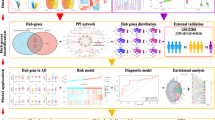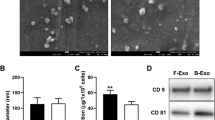Abstract
Objective
Osteoarthritis is a degenerative joint disease, in which matrix metalloproteinase (MMP)-13 plays an important role. This study aimed to investigate miRNA-140-mediated negative regulation of MMP-13 expression in interleukin-1β (IL-1β)-stimulated human cartilage cells.
Methods
The human cartilage cell line C28/I2 was cultured in the presence of IL-1β to mimic an osteoarthritic environment. Expression of miRNA-140 and MMP-13 was analyzed after 48 h by real-time RT-PCR and western blot analyses. MiRNA-140 mediated regulation of MMP-13 expression was analyzed by luciferase reporter assays and anti-miRNA-140 oligonucleotide transfection. Furthermore, miRNA-140 and MMP-13 expression was analyzed following DHMEQ treatment.
Results
Expression of miRNA-140 and MMP-13 was elevated in IL-1β-stimulated C28/I2 cells. Bioinformatic prediction showed that the 3′-UTR of MMP-13 mRNA contained a potential binding miRNA-140 site and luciferase mRNA fused with 3′-UTR of MMP-13 mRNA was shown to be repressed by miRNA-140 in reporter assays. Expression of MMP-13 was elevated in IL-1β-stimulated C28/I2 cells following anti-miRNA-140 oligonucleotide transfection. NF-κB activity was inhibited in DHMEQ treated IL-1β-stimulated C28/I2 cells and was associated with decreased miRNA-140 and MMP-13 expression.
Conclusion
Expression of miRNA-140 and MMP-13 was induced by IL-1β. Expression of miRNA-140 inhibited MMP-13 in C28/I2 cells. Expression of miRNA-140 and MMP-13 was shown to be NF-κB-dependent.



Similar content being viewed by others
References
Schlaak JF, Pfers I, Meyer Zum Buschenfelde KH, Marker-Hermann E. Different cytokine profiles in the synovial fluid of patients with osteoarthritis, rheumatoid arthritis and seronegative spondylarthropathies. Clin Exp Rheumatol. 1996;14:155–62.
Aigner T, McKenna L. Molecular pathology and pathobiology of osteoarthritic cartilage. Cell Mol Life Sci. 2002;59:5–18.
Goldring MB, Marcu KB. Cartilage homeostasis in health and rheumatic diseases. Arthritis Res Ther. 2009;11:224.
Aigner T, Fundel K, Saas J, Gebhard PM, Haag J, Weiss T, et al. Large-scale gene expression profiling reveals major pathogenetic pathways of cartilage degeneration in osteoarthritis. Arthritis Rheum. 2006;54:3533–44.
Aigner T, McKenna L, Zien A, Fan Z, Gebhard PM, Zimmer R. Gene expression profiling of serum- and interleukin-1 beta-stimulated primary human adult articular chondrocytes––a molecular analysis based on chondrocytes isolated from one donor. Cytokine. 2005;31:227–40.
Aigner T, Soeder S, Haag J. IL-1β and BMPs––interactive players of cartilage matrix degradation and degeneration. Eur Cell Mater. 2006;12:49–56.
Sato T, Konomi K, Yamasaki S, Aratani S, Tsuchimochi K, Yokouchi M, et al. Comparative analysis of gene expression profiles in intact and damaged regions of human osteoarthritic cartilage. Arthritis Rheum. 2006;54:808–17.
Yamane S, Ishida S, Hanamoto Y, Kumagai K, Masuda R, Tanaka K, et al. Proinflammatory role of amphiregulin, an epidermal growth factor family member whose expression is augmented in rheumatoid arthritis patients. J Inflamm (Lond). 2008;5:5.
Chambers MG, Cox L, Chong L, Suri N, Cover P, Bayliss MT, et al. Matrix metalloproteinases and aggrecanases cleave aggrecan in different zones of normal cartilage but colocalize in the development of osteoarthritic lesions in STR/ort mice. Arthritis Rheum. 2001;44:1455–65.
Taganov KD, Boldin MP, Baltimore D. MicroRNAs and immunity: tiny players in a big field. Immunity. 2007;26:133–7.
Sonkoly E, Stahle M, Pivarcsi A. MicroRNAs and immunity: novel players in the regulation of normal immune function and inflammation. Semin Cancer Biol. 2008;18:131–40.
Kobayashi T, Lu J, Cobb BS, Rodda SJ, McMahon AP, Schipani E, et al. Dicer-dependent pathways regulate chondrocyte proliferation and differentiation. Proc Natl Acad Sci USA. 2008;105:1949–54.
Araldi E, Schipani E. MiRNA-140 and the silencing of osteoarthritis. Genes Dev. 2010;24(11):1075–80.
Tardif G, Hum D, Pelletier JP, Duval N, Martel-Pelletier J. Regulation of the IGFBP-5 and MMP-13 genes by the microRNAs miR-140 and miR-27a in human osteoarthritic chondrocytes. BMC Musculoskelet Disord. 2009;10:148.
Miyaki S, Sato T, Inoue A, Otsuki S, Ito Y, Yokoyama S, et al. MiRNA-140 plays dual roles in both cartilage development and homeostasis. Genes Dev. 2010;24:1173–85.
Tuddenham L, Wheeler G, Ntounia-Fousara S, Waters J, Hajihosseini MK, Clark I, et al. The cartilage specific miRNA-140 targets histone deacetylase 4 in mouse cells. FEBS Lett. 2006;580:4214–7.
Kao JJ. The NF-kappaB inhibitor pyrrolidine dithiocarbamate blocks IL-1beta induced hyaluronan synthase 1 (HAS1) mRNA transcription, pointing at NF-kappaB dependence of the gene HAS1. Exp Gerontol. 2006;41(6):641–7.
Matsumoto N, Ariga A, To-e S, Nakamura H, Agata N, Hirano S, et al. Synthesis of NF-kappaB activation inhibitors derived from epoxyquinomicin C. Bioorg Med Chem Lett. 2000;10(9):865–9.
Krutzfeldt J, Rajewsky N, Braich R, Rajeev KG, Tuschl T, Manoharan M, et al. Silencing of microRNAs in vivo with ‘antagomirs’. Nature. 2005;438:685–9.
Alcaraz MJ, Megías J, García-Arnandis I, Clérigues V, Guillén MI. New molecular targets for the treatment of osteoarthritis. Biochem Pharmacol. 2010;80(1):13–21.
Hashimoto M, Nakasa T, Hikata T, Asahara H. Molecular network of cartilage homeostasis and osteoarthritis. Med Res Rev. 2008;28:464–81.
Nakasa T, Miyaki S, Okubo A, Hashimoto M, Nishida K, Ochi M, et al. Expression of microRNA-146 in rheumatoid arthritis synovial tissue. Arthritis Rheum. 2008;58:1284–92.
Bhaumik D, Scott GK, Schokrpur S, Patil CK, Campisi J, Benz CC. Expression of microRNA-146 suppresses NF-kappaB activity with reduction of metastatic potential in breast cancer cells. Oncogene. 2008;27:5643–7.
Li X, Gibson G, Kim JS, Kroin J, Xu S, van Wijnen AJ, et al. MicroRNA-146a is linked to pain-related pathophysiology of osteoarthritis. Gene. 2011;480:34–41.
Taganov KD, Boldin MP, Chang KJ, Baltimore D. NF-kappaB-dependent induction of microRNA miR-146, an inhibitor targeted to signaling proteins of innate immune responses. Proc Natl Acad Sci USA. 2006;103:12481–6.
Perry MM, Moschos SA, Williams AE, Shepherd NJ, Larner-Svensson HM, Lindsay MA. Rapid changes in microRNA-146a expression negatively regulate the IL-1beta-induced inflammatory response in human lung alveolar epithelial cells. J Immunol. 2008;180(8):5689–98.
Jones SW, Watkins G, Le Good N, Roberts S, Murphy CL, Brockbank SM, et al. The identification of differentially expressed microRNA in osteoarthritic tissue that modulate the production of TNF-alpha and MMP13. Osteoarthr Cartil. 2009;17:464–72.
Iliopoulos D, Malizos KN, Oikonomou P, Tsezou A. Integrative microRNA and proteomic approaches identify novel osteoarthritis genes and their collaborative metabolic and inflammatory networks. PLoS ONE. 2008;3:e3740.
Jones JI, Gockerman A, Busby WH Jr, Camacho-Hubner C, Clemmons DR. Extracellular matrix contains insulin-like growth factor binding protein-5: potentiation of the effects of IGF-I. J Cell Biol. 1993;121:679–87.
Acknowledgments
This work was supported by grants from the Natural Science Foundation of Guangdong Provence, China (7004817), and the Science and Technology Planning Project of Guangdong Province, China (2007B031400004).
Conflict of interest
The authors state no conflict of interest.
Author information
Authors and Affiliations
Corresponding author
Additional information
Responsible editor: John Di Battista.
Rights and permissions
About this article
Cite this article
Liang, Zj., Zhuang, H., Wang, Gx. et al. MiRNA-140 is a negative feedback regulator of MMP-13 in IL-1β-stimulated human articular chondrocyte C28/I2 cells. Inflamm. Res. 61, 503–509 (2012). https://doi.org/10.1007/s00011-012-0438-6
Received:
Revised:
Accepted:
Published:
Issue Date:
DOI: https://doi.org/10.1007/s00011-012-0438-6




